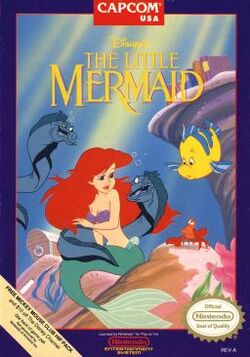Software:The Little Mermaid (video game)
| The Little Mermaid | |
|---|---|
 | |
| Developer(s) | Capcom[lower-alpha 1] |
| Publisher(s) | Capcom |
| Producer(s) | Tokuro Fujiwara |
| Composer(s) | Yasuaki Fujita (NES) Hitoshi Sakimoto (GB) |
| Series | The Little Mermaid |
| Platform(s) | Nintendo Entertainment System, Game Boy |
| Release | August 1991[2] |
| Genre(s) | Action |
| Mode(s) | Single-player |
The Little Mermaid is a licensed action game by Capcom for the NES and Game Boy, based on the 1989 Disney film of the same name.
Gameplay
The game begins underwater, where Ariel can shoot bubbles to trap her foes and throw them. She can also dig through sand to find treasure and pick up sea shells to break open treasure chests. Treasure chests contain power-ups to increase her bubbles' power and range. Ariel can collect icons scattered throughout the levels to restore health, gain extra lives, or increase the range/power of her bubbles. There are six stages that Ariel must traverse to find Ursula. The stages are The Coral Sea, Sunken Ship, Sea of Ice, Undersea Volcano, and finally two battles at Ursula's Castle.
NES and Game Boy differences
When a stage begins, Ariel descends from the top of the screen to the recommended starting point in the NES version, but just starts out in the recommended position in the Game Boy version. The featured SFX are different in both versions. The start of the stage's BGM can be heard only once in the NES version; although the whole BGM can be repeated in the Game Boy version. The stage backgrounds were more restricted in the Game Boy version than in the NES version. When the player loses a heart, the heart turns into a heart frame in the NES version, but disappears in the Game Boy version. The key scales of the Boss BGM are different in both versions. The BGM speed in the NES version is much faster than in the Game Boy version.
Reception
| Reception | ||||||||||||||||||||
|---|---|---|---|---|---|---|---|---|---|---|---|---|---|---|---|---|---|---|---|---|
| ||||||||||||||||||||
Sales
The game sold 500,000 copies by December 1991.[13] It was a major hit among female audiences, who accounted for the vast majority of the game's player base.[14]
See also
- List of Disney video games
Notes
References
- ↑ "Hardcore Gaming 101: A History of Korean Gaming". http://hg101.kontek.net/korea/specials/special-fortheworld.htm.
- ↑ "Video games target young girls". August 3, 1991. p. 41. https://www.newspapers.com/clip/84997116/the-little-mermaid-release-date/. Retrieved September 5, 2021.
- ↑ Harris, Steve; Semrad, Ed; Alessi, Martin; Sushi-X (August 1991). "Little Mermaid". Electronic Gaming Monthly 4 (8): 24. https://archive.org/details/Electronic_Gaming_Monthly_Issue_025_August_1991/page/n23/mode/2up?q=%22American+Gladiators%22+%22electronic+gaming+monthly%22. Retrieved September 6, 2021.
- ↑ Sandrie (July 1994). "Ariel The Little Mermaid" (in de). Mega Fun: 108. https://segaretro.org/index.php?title=File:MegaFun_DE_1994-07.pdf&page=67. Retrieved September 6, 2021.
- ↑ "Now Playing". Nintendo Power 45: 102–106. February 1993. https://archive.org/details/nintendo-power-issue-127-december-1999/Nintendo%20Power%20Issue%20045%20February%201993/page/102/mode/2up?q=%22little+mermaid%22+nes. Retrieved September 6, 2021.
- ↑ "Your Guide to the Latest NES Releases". Nintendo Power 26: 87. July 1991. https://archive.org/details/nintendo-power-issue-127-december-1999/Nintendo%20Power%20Issue%20026%20July%201991/page/81/mode/2up. Retrieved September 6, 2021.
- ↑ Camron, Marc (March 1993). "The Little Mermaid". Electronic Games: 84. https://archive.org/details/Electronic-Games-1993-03/page/n83/mode/2up?q=%22little+mermaid%22+. Retrieved September 6, 2021.
- ↑ Sharon (April 1993). "Little Mermaid". GB Action (11): 26–27. https://archive.org/details/gb-action-11/page/26/mode/2up?q=%22little+mermaid%22+nes. Retrieved September 6, 2021.
- ↑ ACE (September 1992). "The Little Mermaid". N-Force (3): 52–53. https://archive.org/details/nforce-magazine-03/page/n51/mode/2up. Retrieved September 6, 2021.
- ↑ "The Little Mermaid" (in de). Play Time: 95. July 1993. https://archive.org/details/playtime199307/page/n77/mode/2up?q=mermaid. Retrieved September 6, 2021.
- ↑ Schneider, Ulf (July 1994). "Arielle" (in de). Play Time: 152. https://archive.org/details/playtime199407/page/n145/mode/2up?q=mermaid. Retrieved September 6, 2021.
- ↑ "The Little Mermaid" (in pt). VideoGame 1 (9): 30–32. December 1991. https://archive.org/details/videogame_09_12-91/page/30/mode/2up?view=theater. Retrieved September 6, 2021.
- ↑ Peltz, James (December 14, 1991). "THQ's Video-Game Success Comes With Betting on Winners". p. 265. https://www.newspapers.com/clip/84996940/. Retrieved September 5, 2021.
- ↑ Langberg, Mike (13 May 1995). "Game makers target women". Northwest Florida Daily News: p. 30. https://newspaperarchive.com/northwest-florida-daily-news-may-13-1995-p-30/. "Capcom USA Inc. in Sunnyvale, Calif., had a big hit in 1990 and 1991 with a video-game version of "The Little Mermaid," played almost exclusively by girls."
External links
 |

